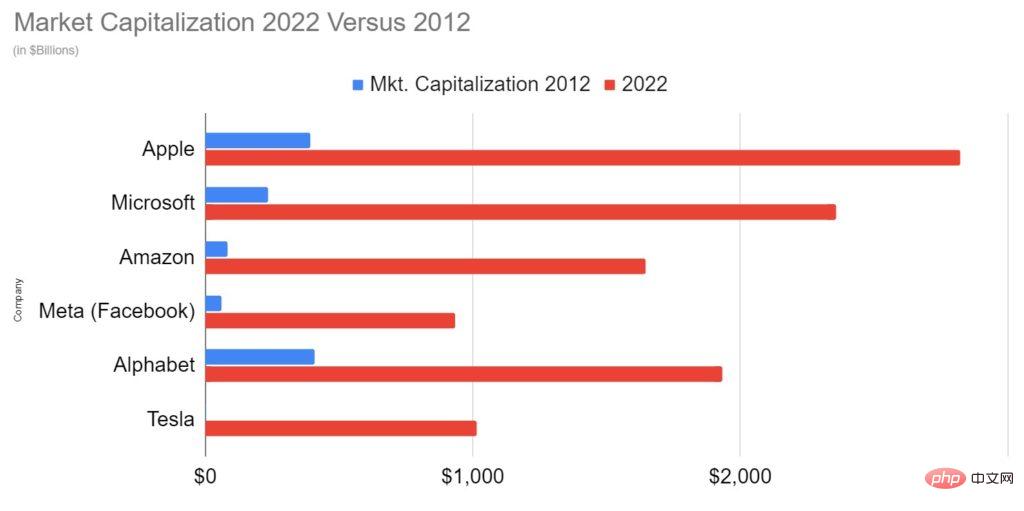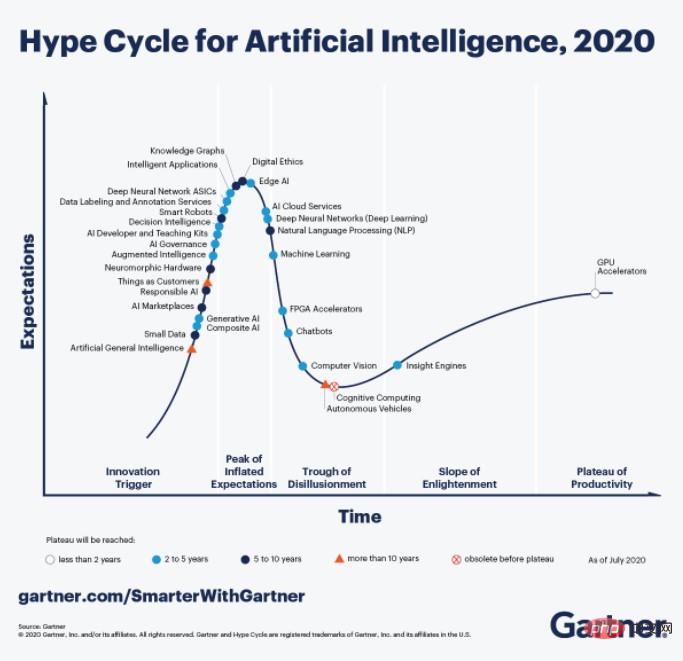Ten years of development history of Google Knowledge Graph

In 2018, Gartner first announced knowledge graphs as an emerging technology; the 1996 Resource Description Framework (a graph data that cleared the way for standard subject-verb-object semantics It took a full 26 years after the advent of the knowledge graph to reach the peak of the maturity curve.
10 years ago, Google (now a subsidiary of holding company Alphabet) mentioned the term "knowledge graph" and generally described how its knowledge graph worked.
20 years ago, Tim Berners-Lee, James Hendler, and Ora Lassila published their first article describing the Semantic Web they envisioned. Many knowledge graphs are built using semantic standards subsequently implemented by the W3C at least 10 years ago.
It’s interesting to think about what happened after that. Over the past decade, Alphabet has gradually grown into one of the six largest companies in the world with a market capitalization (the total value of outstanding shares) of more than $1 trillion.
Here’s where Alphabet ranks compared to its closest IT companies in terms of market cap at the beginning of 2022:

How do these market cap leaders fare in terms of knowledge graphs? As?
I did some desk research to analyze which of these companies shown in the figure have been working on developing knowledge graphs over the past decade:
•Apple acquired the company from Stanford Research Institute in 2010 (SRI) project derived from Siri. Tom Gruber is a co-founder of the SRI team. As a pioneer in the field of human-in-the-loop AI, Gruber published results on the design of a knowledge-sharing ontology at SRI in 1993. Later in 2019, Apple's work notes described the work of its Knowledge Graph Engineering team as follows:

Aaron Bradley via Twitter, January 19, 2019
•Microsoft Research Asia developed Trinity distributed graph storage in 2010 and published its in-memory RDF graph function in a 2013 paper. For years, Satori has been Microsoft's version of a knowledge/fact graph, similar to Google's Knowledge Graph. Microsoft Academic Knowledge Graph (MAKG) appeared around 2019. The company mentioned in a 2022 job opening for a data and analytics scientist that driving "innovation in business knowledge graph models and algorithms" as a requirement for the position.
•For years, Amazon seemed hesitant to hire ontology professionals, but in the late 2010s it embarked on developing a product knowledge graph. The Alexa conversational assistant is based on the knowledge graph, Alexa's Meaning Representation Language (MRL) is based on the graph, and a paper on the topic was published in 2016. The Alquist team from the Czech Technical University won the 4th Annual Alexa Award for the conversational knowledge graph that is the basis of the 2020 Alquist 3.0 smart assistant.
•Meta (Facebook) announced the Facebook Graph in March 2013, making it available to all U.S. English-speaking users of Facebook by June 2013. The graph contains information on one billion different Facebook users at the time. Graph will continue to be available to users in 2022.
•Alphabet (Google) announced its knowledge graph in 2012 and continues to have ontology professionals and data architects experienced in semantic standards on its staff.
•Tesla – I haven’t found any evidence that Tesla is using knowledge graphs.
Google’s early knowledge graph
Here is an illustration used by Google to describe its knowledge graph. This is a directed graph with named entities (Leonardo Da Vinci, Mona Lisa, and the Louvre) and named relationships that show the relationships between the entities.

This diagram illustrates the contextual fragments that can be developed and connect the Tinker Toy style to another compatible semantic diagram, a process of deeper integration than linking Relational tables are much simpler and more scalable. To reduce the number of clicks to obtain information, Google then populates the knowledge panel with a selection of da Vinci fragments, with the content displayed directly on the results page. By 2016, there were 100 billion search results per month on Google, and a third of them were accompanied by a knowledge panel.
Google search results page usually responds quickly to return results, and the search engine and algorithm will ensure whether you are interested in these search results.
Knowledge Graph of the 2020s
Fast forward to 2020. Gartner subsequently plotted the knowledge graph near the peak of the period of inflated expectations in its Artificial Intelligence Hype Cycle.

In 2018, Gartner first announced knowledge graphs as an emerging technology; the 1996 Resource Description Framework (a resource description framework that cleared the way for standard subject-verb-object semantics A full 26 years after the advent of the graph data model, the knowledge graph has reached the peak of the maturity curve.
Of course, it is worth noting that the theory behind neural networks dates back to 1873, and the specific research focus on neural networks in AI began in 1943. But it was not until the 1990s that computing, networking, and storage made great progress, and neural networks took hold. Many AI experts say that today's neural network algorithms bear a passing resemblance to those developed when "AI" was just getting started.
Slowly evolving technologies may be most impactful
Many other enterprises have made significant progress with their respective implementations of knowledge graphs. From February 28 to March 1, Semantic Arts held its first online event on enterprise data transformation and knowledge graph adoption. Some of the speakers include the following:
•Parsa Mirhaji of Montefiore Hospital
•Thomas Hubauer of Siemens
•Ben Gardner and Colin Wood of AstraZeneca
•IKEA’s Katarinna Kari
•Swatch Group’s Peter Hutzli
It’s too early to say that knowledge graphs have gone mainstream, but it’s clear that more and more Fortune 》Global 1000 companies are adopting this technology for many different uses.
Original title: Ten years of Google Knowledge Graph
Author: Alan Morrison
Article source: https://www.datasciencecentral.com/ten-years-of- google-knowledge-graph/
The above is the detailed content of Ten years of development history of Google Knowledge Graph. For more information, please follow other related articles on the PHP Chinese website!

Hot AI Tools

Undresser.AI Undress
AI-powered app for creating realistic nude photos

AI Clothes Remover
Online AI tool for removing clothes from photos.

Undress AI Tool
Undress images for free

Clothoff.io
AI clothes remover

Video Face Swap
Swap faces in any video effortlessly with our completely free AI face swap tool!

Hot Article

Hot Tools

Notepad++7.3.1
Easy-to-use and free code editor

SublimeText3 Chinese version
Chinese version, very easy to use

Zend Studio 13.0.1
Powerful PHP integrated development environment

Dreamweaver CS6
Visual web development tools

SublimeText3 Mac version
God-level code editing software (SublimeText3)

Hot Topics
 1386
1386
 52
52
 How to comment deepseek
Feb 19, 2025 pm 05:42 PM
How to comment deepseek
Feb 19, 2025 pm 05:42 PM
DeepSeek is a powerful information retrieval tool. Its advantage is that it can deeply mine information, but its disadvantages are that it is slow, the result presentation method is simple, and the database coverage is limited. It needs to be weighed according to specific needs.
 How to search deepseek
Feb 19, 2025 pm 05:39 PM
How to search deepseek
Feb 19, 2025 pm 05:39 PM
DeepSeek is a proprietary search engine that only searches in a specific database or system, faster and more accurate. When using it, users are advised to read the document, try different search strategies, seek help and feedback on the user experience in order to make the most of their advantages.
 Sesame Open Door Exchange Web Page Registration Link Gate Trading App Registration Website Latest
Feb 28, 2025 am 11:06 AM
Sesame Open Door Exchange Web Page Registration Link Gate Trading App Registration Website Latest
Feb 28, 2025 am 11:06 AM
This article introduces the registration process of the Sesame Open Exchange (Gate.io) web version and the Gate trading app in detail. Whether it is web registration or app registration, you need to visit the official website or app store to download the genuine app, then fill in the user name, password, email, mobile phone number and other information, and complete email or mobile phone verification.
 Why can't the Bybit exchange link be directly downloaded and installed?
Feb 21, 2025 pm 10:57 PM
Why can't the Bybit exchange link be directly downloaded and installed?
Feb 21, 2025 pm 10:57 PM
Why can’t the Bybit exchange link be directly downloaded and installed? Bybit is a cryptocurrency exchange that provides trading services to users. The exchange's mobile apps cannot be downloaded directly through AppStore or GooglePlay for the following reasons: 1. App Store policy restricts Apple and Google from having strict requirements on the types of applications allowed in the app store. Cryptocurrency exchange applications often do not meet these requirements because they involve financial services and require specific regulations and security standards. 2. Laws and regulations Compliance In many countries, activities related to cryptocurrency transactions are regulated or restricted. To comply with these regulations, Bybit Application can only be used through official websites or other authorized channels
 Sesame Open Door Trading Platform Download Mobile Version Gateio Trading Platform Download Address
Feb 28, 2025 am 10:51 AM
Sesame Open Door Trading Platform Download Mobile Version Gateio Trading Platform Download Address
Feb 28, 2025 am 10:51 AM
It is crucial to choose a formal channel to download the app and ensure the safety of your account.
 Sesame Open Door Exchange Web Page Login Latest version gateio official website entrance
Mar 04, 2025 pm 11:48 PM
Sesame Open Door Exchange Web Page Login Latest version gateio official website entrance
Mar 04, 2025 pm 11:48 PM
A detailed introduction to the login operation of the Sesame Open Exchange web version, including login steps and password recovery process. It also provides solutions to common problems such as login failure, unable to open the page, and unable to receive verification codes to help you log in to the platform smoothly.
 Top 10 recommended for crypto digital asset trading APP (2025 global ranking)
Mar 18, 2025 pm 12:15 PM
Top 10 recommended for crypto digital asset trading APP (2025 global ranking)
Mar 18, 2025 pm 12:15 PM
This article recommends the top ten cryptocurrency trading platforms worth paying attention to, including Binance, OKX, Gate.io, BitFlyer, KuCoin, Bybit, Coinbase Pro, Kraken, BYDFi and XBIT decentralized exchanges. These platforms have their own advantages in terms of transaction currency quantity, transaction type, security, compliance, and special features. For example, Binance is known for its largest transaction volume and abundant functions in the world, while BitFlyer attracts Asian users with its Japanese Financial Hall license and high security. Choosing a suitable platform requires comprehensive consideration based on your own trading experience, risk tolerance and investment preferences. Hope this article helps you find the best suit for yourself
 Binance binance official website latest version login portal
Feb 21, 2025 pm 05:42 PM
Binance binance official website latest version login portal
Feb 21, 2025 pm 05:42 PM
To access the latest version of Binance website login portal, just follow these simple steps. Go to the official website and click the "Login" button in the upper right corner. Select your existing login method. If you are a new user, please "Register". Enter your registered mobile number or email and password and complete authentication (such as mobile verification code or Google Authenticator). After successful verification, you can access the latest version of Binance official website login portal.




